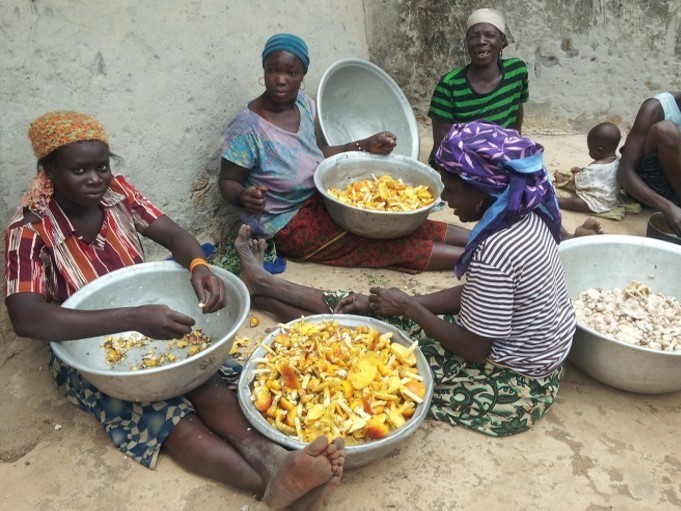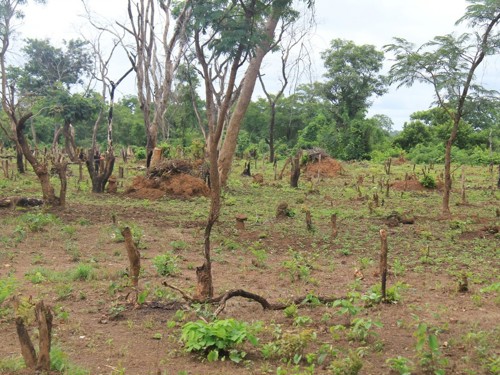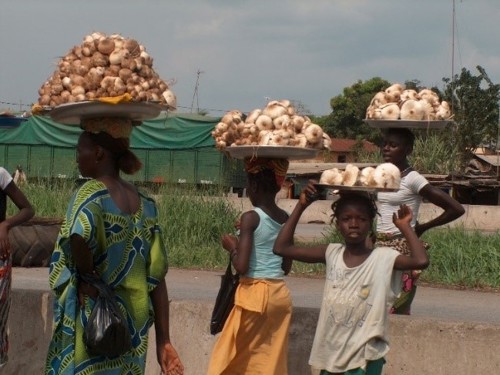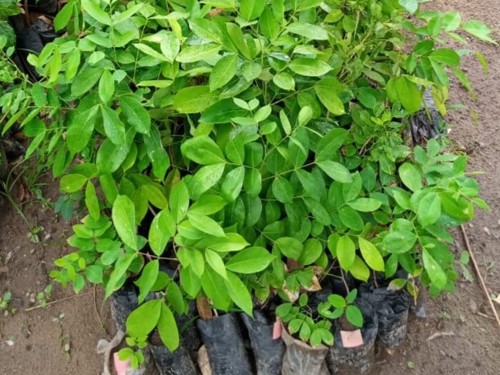Giving fungi a place at the table

Women collecting/ cleaning wild edible mushrooms in Angaradébou village (Benin). Credit - Laourou G. (2017).
The orphans of Rio: Giving fungi a place at the table
Here’s something most people don’t think about. Life on Earth depends on fungi. Everyone recognises that ecosystems need plants (the producers) and animals (the consumers), but where would the world be without the recyclers? Fungi are the missing link. They’re the planet’s refuse workers. They turn nature’s rubbish into nutritious compost and make sure the plants get fed. Add in all the other valuable processes and products they provide - antibiotics, anti-cancer drugs, biological control agents, ecosystem checks and balances, fermentation, food and drinks, industrial enzymes, ruminant symbionts, statins, and so much more - and the message is clear. Without fungi, we wouldn’t be here.
Fungi are also incredibly numerous. Their species run into millions, maybe second only to insects and probably six times more than plants. And they’re wonderfully diverse. Some of creation’s most remarkable organisms are fungi. In short, they’re an indispensable part of nature’s rich heritage. And ‘indispensable’ is the important word, because like animals and plants, fungi have no magical protection against the destruction caused by humans. Faced with climate change, exploitation, habitat loss, persecution, and pollution, they are just as threatened as everything else.

All the more astonishing therefore that just a decade ago fungi were almost totally overlooked by the conservation movement, and that neglect went all the way to the top. Look at any of the hundreds of Rio Convention reports and strategies submitted by countries all over the world - they’re all available from the Convention on Biological Diversity (CBD) website - and you’ll quickly discover that none of them provide even basic cover of these critically important organisms. Excluded from family decisions and with no place, so to speak, at the table, fungi have very appropriately been described as the orphans of Rio.
All that is now changing, and the change is rapid. A far-sighted Darwin Initiative project that begun in 2007 initiated a movement for fungal conservation. The International Union for Conservation of Nature (IUCN) was quick to respond, acknowledging in 2013 that fungal conservation is just as important as protecting animals and plants. Since then, the number of fungi evaluated for its Red List has grown exponentially. New fungal conservation NGOs and societies are appearing, and more and more institutions, organisations, and even governments are including fungi in their biodiversity policies. A tipping point is rapidly approaching when it will become the norm to protect fungi, and conservation work which doesn’t mention them will seem incomplete.
That brings us to the present Darwin Initiative project, which began in June 2023. Its primary concern is the impact of fungal diversity loss on the livelihoods of millions of rural women in Sub-Saharan Africa. As a problem, it’s real, it’s big, and it’s challenging. The project team led by the University of Parakou in Benin, and including participants from the Matobo Conservation Society (Zimbabwe), the Permaculture Association (UK), and Centre for Agriculture and Bioscience International (CABI) (UK), are looking for solutions.
From Senegal to Kenya and all the way down to South Africa, a huge area of land is covered (or rather, used to be covered) by a special type of woodland called ‘miombo.’ A key feature of miombo is that the native trees which grow there are ectomycorrhizal, which means that they have a remarkable and mutually beneficial relationship with particular fungi. The microscopic threads of those fungi surround the tree roots and extend far into the soil. Being so small, the threads get to places the roots cannot reach, giving them a huge advantage in extracting soil nutrients. The tree, however, has advantages of its own. Its leaves photosynthesise sugars from water and carbon dioxide in the atmosphere, meaning they convert sunlight, water, and atmospheric carbon dioxide into sugars and oxygen. Everything is set for an exchange where both sides win. The fungi supply the trees with minerals from the soil, and in return, the tree gives them sugars they can’t make for themselves. Without those mycorrhizal associations, this wonderful forest simply couldn’t survive.
"A tipping point is rapidly approaching when it will become the norm to protect fungi, and conservation work which doesn’t mention them will seem incomplete."
The beauty of it is that the sporophores (organs of the fungi) which are produced by many of these mycorrhizal fungi are large, nutritious, and very good to eat: mushrooms! Right across Sub-Saharan Africa, local people have for centuries collected these mushrooms, and for millions of people they form an important part of their diet.* Historically overlooked by the colonial powers, and taken for granted by Africans themselves, this phenomenon (and, it is phenomenal) has only recently received the interest and attention it deserves.
In fact, a huge commerce exists. The mushrooms are collected not just for home consumption, but also to sell. Enormous quantities make their way to local markets, and throughout Sub-Saharan Africa it’s common to see people selling them at the roadside. Profits can be big enough for individual families, for example, to finance the university education of their children. It’s also a trade with a strong gender bias. Almost all of the collection, preparation, and marketing of these wild mushrooms is done by rural women, and collectively they share an impressive treasure house of experience and expertise in identification, which is transmitted orally from mother to daughter.

There’s one big problem, however. The native miombo woodland which provides these sustainable livelihoods is vanishing at an alarming rate. This precious resource is being reduced to tiny patches of relict woodland, the main culprits of which are logging and charcoal production. Thankfully, it’s now illegal to cut down native woodland in many places, but all too often, that’s hard to police. Destroying a hectare of miombo woodland forever provides an immediate one-off cash prize. Collecting edible mushrooms over a 30-year period from the same land, generates roughly the same income, and the woodland survives. For the unscrupulous, the short-term reward is too tempting. And, so often, it’s men doing the felling, and women whose livelihoods are destroyed.
Solving this problem requires efforts in multiple directions, simultaneously. It’s an urgent and challenging task that requires greater awareness, collaboration, education, and action by the various stakeholders. Starting in Benin, this project is helping suitably-located villages to establish native tree nurseries on, or near, recently destroyed miombo woodland. In these locations, over the life of this project, thousands of saplings will be able to form new associations with surviving mycorrhizal fungi, spreading that beneficial partnership when the young trees are transplanted.
"The impacts of fungal decline are more subtle and take time to appear: refuse collectors are only noticed when they go on strike."
This action by collaborating villages is accompanied by education to raise awareness of two key points: first, that native mycorrhizal fungi and the woodlands where they grow are valuable assets which require protection; and second, that plantations of exotic trees, where native fungi do not form associations, are better sources of charcoal and timber. This message is not just for local people in villages of Benin. It needs to be communicated as widely as possible in all countries where miombo woodland occurs.
If successful, transplanting young mycorrhizal trees will result in regenerated miombo woodland, but this will take years. Putting the land to good use while trees are getting established will be an important consideration. A broad design philosophy is needed, which creates sustainable human habitats and food systems based on observation of natural ecosystems and their patterns. Practical expertise from the Permaculture Association, a UK partner, will be used to encourage regenerative agriculture and food-forests; a holistic approach supporting Indigenous social and cultural values, community self-empowerment, gender equity, and a sense of stewardship of local ecosystems.

A few thousand saplings reared in a few Benin villages where local people appreciate the natural resources they’re restoring is good, but it’s only a start. For this initiative to be effective, scaling-up is essential, and that comes with a whole new set of challenges. Within Benin, operating under a more-or-less uniform cultural environment and a single set of national laws, the project will seek links with other groups working on natural forest restoration. Some are already known, others need to be identified. Collaborating with us will strengthen their efforts by contributing this largely overlooked fungal dimension.
Scaling-up beyond Benin will also be needed. For this, our project has two plans. The first, is to identify suitable partners in countries neighbouring Benin, and invite them to come and see what we’re doing. Then, if they show interest, we would help them get started. The second, further afield, is similar work that’s being done in Zimbabwe, where another part of our team is based. The target woodland is still miombo, but the operating environment is different. A solution which works in Benin may need adjustment to succeed on the other side of the continent.
For a project lasting less than three years, all this is a big task and a lot will be learned. Ultimately, if all goes to plan, we will have spread the message that fungi are indispensable for sustainable life, that miombo woodland is precious, and that millions of livelihoods depend on it. And effectively, local people will be protecting those woodlands and the livelihoods they provide, conservation NGOs will be supporting their efforts, and some miombo will actually be regenerating in Benin and elsewhere.
"Local people will be protecting those woodlands and the livelihoods they provide."
It’s well known that loss of animal and plant diversity impacts our lives in many different ways. The notion that the same happens when fungi decline is perhaps less familiar. One reason is surely that fungi have been routinely overlooked, but it may also be that the impacts of fungal decline are more subtle and take time to appear: refuse collectors are only noticed when they go on strike. With that in mind, another part of this project is to seek and identify those impacts – a horizon-scanning exercise – to reduce our shock when those impacts do eventually appear.
That leads to the final output of this project. Every country participating in the CBD has a national focus point. It’s this person’s job to make sure convention obligations are met. Many recognise that fungi are missing from their country’s reports and, for Sub-Saharan Africa, several have said they would welcome expert help and advice. Starting with those countries, all the information and experience generated by this work will be shared with each national focus point in an easily digestible format, together with any additional support possible. Having fungi receive adequate protection from the CBD would be a wonderful outcome for this project.
Written by David Minter (CABI), Cathy Sharp (Matobo Conservation Society), Gihan Soliman (Permaculture Association), and Nourou Yorou (University of Parakou). For more information on this Darwin Initiative Main project 30-020, led by the University of Parakou, please click here.
_________________________________________________________________________________________________________
*As an aside, this tradition of collecting wild mushrooms extends far beyond miombo woodland: huge edible sporophores are also produced in abundance by fungi which live in Africa’s ubiquitous termite mounds, employing the insects to gather and prepare their food... and yes, our project is working with these amazing species too... but that is another story.

 Back
Back